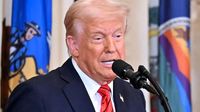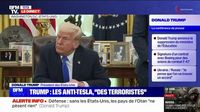On March 21, 2025, President Donald Trump stood at the White House podium, making bold proclamations concerning U.S. tariffs during a brief press conference. He emphasized the importance of NATO, stating that member countries are 'reinvesting in their defense'—a nod to the U.S. role in global security. However, it was Trump's announcement about tariffs that captured immediate attention. In a move that could reshape U.S.-Canada relations, he has decided to double the tariffs on aluminum and steel imports from Canada to a staggering 50%.
The new tariffs are a direct counter to Ontario Premier Doug Ford’s recently implemented 25% tariff on U.S. electricity imports. Ford announced the temporary suspension of this electricity tariff just hours before Trump’s press conference, following an agreement with U.S. representatives to hold negotiations aimed at easing tensions. However, Trump’s doubling of tariffs on aluminum and steel suggests he is willing to escalate the trade conflict, indicating that the U.S. is ready to fight back.
In the same breath, Trump hinted at a dramatic increase in tariffs on vehicles entering the U.S. from Canada, warning that such measures could 'essentially close down' Canada’s automotive industry if implemented. He pointed to April 2, 2025, as a pivotal date, labeling it the 'Day of Liberation' for the United States.
On this day, reciprocal tariffs on a wide range of products will come into effect. Trump's strategy suggests that all goods entering the U.S. will face the same tariffs imposed by the exporting country on American products, effectively raising costs for imports from other nations that have been, as he described, 'taking advantage of the U.S. for decades.'
The anticipated shift in tariff policy sent ripples of concern through business sectors and stock markets alike. Traders expressed apprehension, fearing that impending tariffs could further strain U.S.-Canada trade relations and spot vulnerabilities in sourcing materials. The immediate aftermath of these announcements saw noticeable declines in stock prices as investors reacted to the uncertainty laced with the potential upcoming tariffs.
During his announcement, Trump didn't shy away from calling out historical grievances. He asserted, "For decades, we have been scammed and mistreated by every nation, both allies and enemies. Now, it’s finally time for us good old United States to reclaim some of that money and be respected again." His rhetoric seems designed to rally support from his base, projecting a posture of economic nationalism and direct confrontation on trade.
Addressing the media, White House spokesperson Karoline Leavitt reinforced Trump's message, declaring, "This will be a great day for our country," as she confirmed that the reciprocal tariffs would indeed begin on April 2, 2025. The definitive nature of Trump's strategy aims to unify U.S. trade interests amidst rising global tension over tariffs and international trade agreements.
Ford’s response to Trump’s tariffs echoed the concerns of many Canadian officials. By imposing tariffs on U.S. electricity, Ford likely sought to exert pressure on the U.S. administration to reconsider its stance. With Trump’s latest round of tax hikes announced, it remains to be seen how the Canadian government will adapt moving forward. The dynamics at play suggest escalating negotiations are imminent, particularly as the automotive sector braces for disruption.
The timeline for these tariffs unfolding on April 2 will not only impact trade relations but also potentially destabilize existing agreements and partnerships. Keeping trade open between Canada and the U.S. has long been a core principle for both nations. However, with Trump's administration indicating that these tariffs are here to stay, discussions will likely be heated leading up to the deadline.
As various industries—including manufacturing and automotive—gear up to adapt to these new economic realities, the public, investors, and policymakers are left to watch how this saga will shift the U.S.-Canada trade landscape in the long term. The uncertainty this creates can often prove detrimental as markets thrive on predictability and stability.
In summary, not only does Trump's trade policy initiative reflect his administration's ongoing commitment to economic nationalism, but it also underscores the delicate balance required in maintaining fruitful relationships with international partners. As April 2 approaches, the stakes remain high, and many are left wondering just how far these tensions will escalate in the name of American prosperity.
In these dynamic global trade discussions, time will reveal whether Trump's aggressive tariff policies will lead to increased U.S. revenues or if they will instead foster detrimental retaliatory measures from affected countries, a scenario that could deepen trade deficits rather than resolve them.



